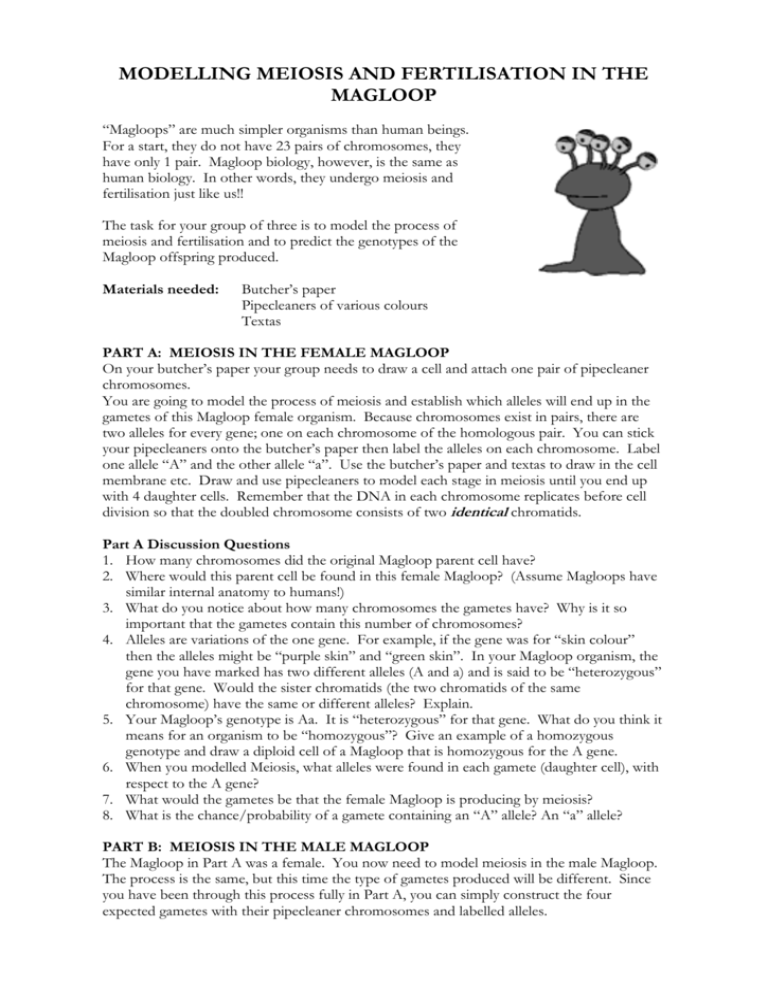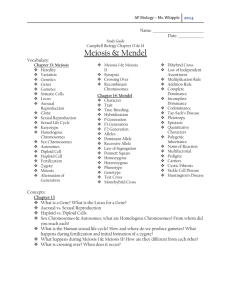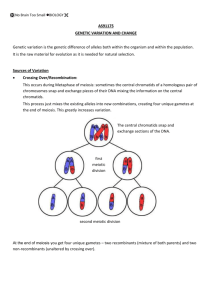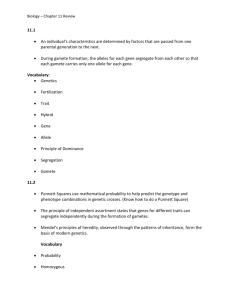modelling meiosis and fertilisation in the magloop
advertisement

MODELLING MEIOSIS AND FERTILISATION IN THE MAGLOOP “Magloops” are much simpler organisms than human beings. For a start, they do not have 23 pairs of chromosomes, they have only 1 pair. Magloop biology, however, is the same as human biology. In other words, they undergo meiosis and fertilisation just like us!! The task for your group of three is to model the process of meiosis and fertilisation and to predict the genotypes of the Magloop offspring produced. Materials needed: Butcher’s paper Pipecleaners of various colours Textas PART A: MEIOSIS IN THE FEMALE MAGLOOP On your butcher’s paper your group needs to draw a cell and attach one pair of pipecleaner chromosomes. You are going to model the process of meiosis and establish which alleles will end up in the gametes of this Magloop female organism. Because chromosomes exist in pairs, there are two alleles for every gene; one on each chromosome of the homologous pair. You can stick your pipecleaners onto the butcher’s paper then label the alleles on each chromosome. Label one allele “A” and the other allele “a”. Use the butcher’s paper and textas to draw in the cell membrane etc. Draw and use pipecleaners to model each stage in meiosis until you end up with 4 daughter cells. Remember that the DNA in each chromosome replicates before cell division so that the doubled chromosome consists of two identical chromatids. Part A Discussion Questions 1. How many chromosomes did the original Magloop parent cell have? 2. Where would this parent cell be found in this female Magloop? (Assume Magloops have similar internal anatomy to humans!) 3. What do you notice about how many chromosomes the gametes have? Why is it so important that the gametes contain this number of chromosomes? 4. Alleles are variations of the one gene. For example, if the gene was for “skin colour” then the alleles might be “purple skin” and “green skin”. In your Magloop organism, the gene you have marked has two different alleles (A and a) and is said to be “heterozygous” for that gene. Would the sister chromatids (the two chromatids of the same chromosome) have the same or different alleles? Explain. 5. Your Magloop’s genotype is Aa. It is “heterozygous” for that gene. What do you think it means for an organism to be “homozygous”? Give an example of a homozygous genotype and draw a diploid cell of a Magloop that is homozygous for the A gene. 6. When you modelled Meiosis, what alleles were found in each gamete (daughter cell), with respect to the A gene? 7. What would the gametes be that the female Magloop is producing by meiosis? 8. What is the chance/probability of a gamete containing an “A” allele? An “a” allele? PART B: MEIOSIS IN THE MALE MAGLOOP The Magloop in Part A was a female. You now need to model meiosis in the male Magloop. The process is the same, but this time the type of gametes produced will be different. Since you have been through this process fully in Part A, you can simply construct the four expected gametes with their pipecleaner chromosomes and labelled alleles. Part B Discussion Questions 9. What cells would be undergoing meiosis in the male Magloop? 10. What would the gametes be that are being produced? PART C: MODELLING FERTILISATION You now need to redraw the four female and four male gametes side-by-side on the same sheet of butcher’s paper. This next step might take a bit of space! It is time to model the process of fertilisation. In the process of fertilisation, one egg cell randomly meets one sperm cell. These cells fuse together and the resulting “zygote” has the normal number of chromosomes. EGG SPERM CELL + contains 1 chromosome contains 1 chromosome ZYGOTE Contains 1 pair of chromosomes How many possible ways can one egg combine with one sperm? You need to show on your butcher’s paper ALL the zygotes it is possible to form. Each zygote will eventually form a new Magloop due to mitosis. All cells in the Magloop will contain the genotype (combination of alleles) of the zygote. Write down the genotypes for each new Magloop offspring it is possible to form. Part C Discussion Questions 11. How many different genotypes are possible in the offspring from these two Magloops? What are these genotypes? (Write down the allelic combinations). 12. If a second fertilisation was to happen, what genotypes do you think it would be possible to produce in the offspring? Explain. 13. In humans, how many chromosomes are found in the gametes? Are they paired or unpaired chromosomes? Explain the importance of the gametes having this number of chromosomes. In your explanation, demonstrate your understanding of meiosis and use the term “homologous chromosome”. 14. How many alleles are possible for an individual to possess for each gene? Explain fully. Conclusion Summarise the key points you have learnt about the process of meiosis including the outcomes (end products) of meiosis and of what importance this process is in sexual reproduction. This is an assessed practical and must be written up as a formal practical report.








